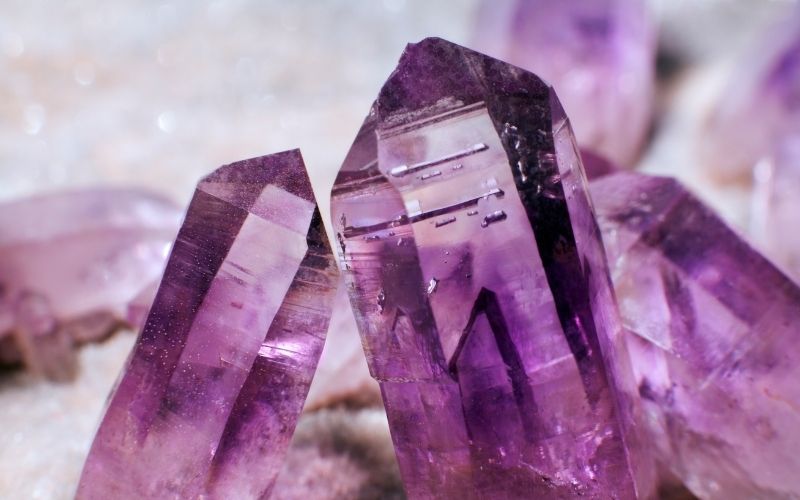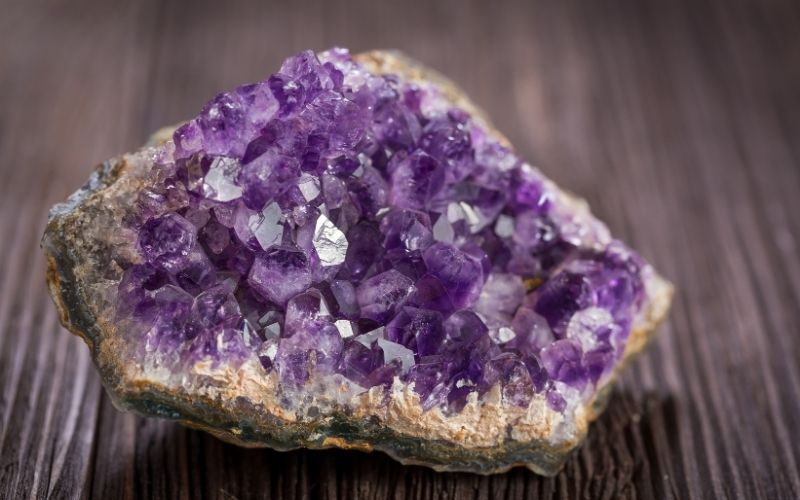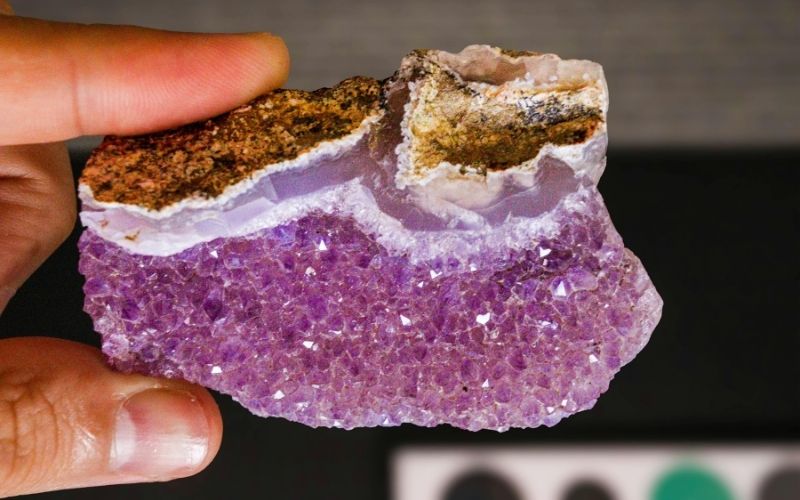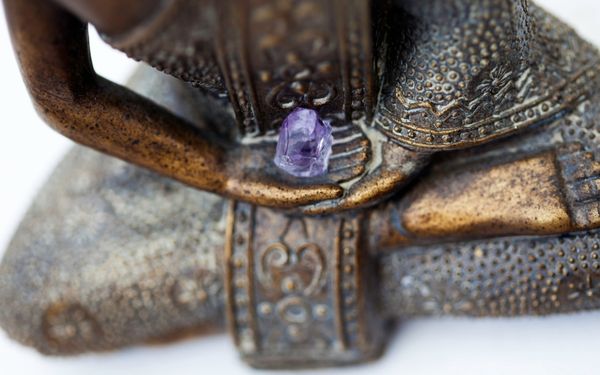Amethyst crystal | Properties and Uses
From ancient Greek myths to modern meditation rooms, the amethyst has carried a reputation far beyond its purple beauty. People reach for this stone when they want calm, focus, or simply a sense of connection. While science sees it mostly as quartz, countless cultures have given it meaning — from protecting travelers to easing sleepless nights.

Crystals have long been known for their healing properties. Whether you’re new to the crystal scene or are a seasoned collector, the amethyst is a stone that often finds its way into people’s lives. Known for its calming and soothing properties, the amethyst is popularly used to provide emotional balance, promote restful sleep, and enhance spiritual awareness. It is also believed to aid in relieving stress, anxiety, and irritability, and can even improve our ability to focus.
We’ll take a closer look at the amethyst, exploring its origins, its historical uses, and its place in contemporary wellness practices. We’ll also dive into the various ways in which the amethyst is thought to promote healing and well-being and provide you with tips and techniques for incorporating amethyst crystals into your self-care routine.
We are delighted to have Rini stamp writing this guide for us. Rini is a Healer, Reiki Master, and Certified Crystal Healer Practitioner. She is the creator of wellness platform that helps individuals reconnect to their best life through healing and spiritual empowerment. Rini is deeply passionate about supporting others on their healing journey and uses her extensive knowledge to guide and nurture others in their quest for a more mindful and balanced life.
2. 1.2″ Large Heart Crystals
3. Amethyst Crystal Rock
The Science of Healing
The Placebo Effect: Harnessing the Power of the Mind
When it comes to understanding healing, it is essential to recognize the role that the mind can play in our well-being. The placebo effect is a perfect example of how our thoughts and beliefs can influence our physical health.
Research hasn’t proven that amethyst “heals” in a medical sense. A 2014 review on alternative medicine highlighted that the placebo effect can play a powerful role — meaning if someone believes the stone helps, their body often responds positively. So while the crystal isn’t a cure, the comfort and ritual around it can still make a real difference.
When people were given a placebo and told that it would help reduce their anxiety, the level of activation in the amygdala, a part of the brain involved in processing emotions, actually decreased.
This study offers a compelling insight into the ways in which our thoughts and beliefs can impact our emotional state and shows that our minds are powerful tools for managing stress and promoting a sense of calmness and positivity. Crystals are a tangible reminder of this connection between our thoughts and our well-being. When we work with crystals with a clear intention, we can create positive outcomes that are grounded in a focused and balanced mind.
How Amethyst Support Well-being
Crystals are often celebrated for their aesthetic beauty, but it is their molecular structure that makes them truly captivating. From a scientific perspective, crystals are formed from repeating patterns of molecules, which creates a unique resonance and vibration. It is this vibrational quality that sets crystals apart and makes them a valuable tool for promoting healing and emotional harmony.
Our bodies also have their own vibrational energy, which is often referred to as our life force or our vital energy. When our energy is low, we may feel tired, run down, or unwell. Conversely, when our energy is high, we can feel invigorated and ready to take on the world. Amethyst crystals are thought to interact with our energy system, helping to bring it into balance and harmony.
Amethyst History and Mythology
The amethyst has always been one of the most prized and treasured crystals. Since ancient times, it has been associated with royalty and has held a special place in jewellery and decorative arts.
The name itself comes from the ancient Greek word “amethystos,” which means “not drunk” and reflects the belief that the stone could prevent intoxication. Over the centuries, the amethyst has been the subject of many myths and legends, and its unique beauty has captured the imaginations of people across cultures and civilizations.

Amethyst: Ancient Uses and Symbolism
The amethyst holds a special place in the lore of many ancient cultures. In Egypt, it was associated with protection and was used to ward off evil spirits. The ancient Greeks and Romans believed that the amethyst could prevent intoxication and promote a clear mind.
In fact, the Greeks would often adorn their goblets with amethysts, while the Romans would wear them as jewellery during feasts and celebrations. The Christian church also has a long-standing connection to the amethyst. It is often associated with purity and is a symbol of the connection between the spiritual and the material.
Throughout history, the amethyst has been prized for its spiritual significance and its ability to support inner harmony and balance. Its calming and soothing properties have made it a popular stone for meditation and other contemplative practices. Even today, the amethyst is used by healers and wellness practitioners to help individuals achieve a sense of emotional well-being and spiritual awareness.
Geographical Origins
The geological origins of the amethyst are just as fascinating as its historical and cultural significance.
Amethysts are a type of quartz crystal and are part of the vast family of minerals that make up the Earth’s crust. They are formed in geodes, which are small cavities or hollow spaces in rocks. Over time, water rich in silica seeps into these cavities and begins to crystallize. As the crystals grow, they take on different shapes and structures, depending on the conditions in which they form. This is why amethyst crystals can be found in a variety of sizes and have diverse appearances.
From pale lilac to deep purple, the color of the amethyst can also vary, and this is determined by the presence of certain trace minerals in the crystal.
Amethysts can be found all over the world, and each geographical location can impart unique qualities to the crystals.
Finding the Perfect Amethyst
Whether you are drawn to their beauty, want to add positive energy to your life, or are looking for a specific tool to support your well-being, amethyst crystals are a wonderful addition to anyone’s collection. As every amethyst is unique, you may wonder how to choose the right one for you. In this section, we explore the different types of amethyst, provide tips for selecting the best crystal for your needs, and offer guidance on caring for your amethyst once it is in your care.
Types of Amethyst
Amethyst crystals can vary in colors and sizes, but there are also specific types of amethyst that are associated with certain locations. As mentioned in the previous section, the geographical origin of an amethyst can influence its appearance and its metaphysical properties.
Here are some of the most well-known types of amethyst:
Brazilian Amethyst
Brazil is one of the largest suppliers of amethyst, and its crystals are celebrated for their deep color and clarity.
Brazilian amethysts tend to have a rich purple hue and are often free from inclusions. They are also known for their large sizes, making them a popular choice for statement pieces and home decor.
Uruguay Amethyst
Amethysts from Uruguay are prized for their intense color and their exceptional transparency. They often have a deep, reddish-purple hue and can come in a variety of shapes, including geodes and clusters.
Uruguay amethysts are also known for their high vibrational energy and are a favorite choice for healing work.
African Amethyst
Africa is a vast continent, and it is home to a wide variety of amethyst crystals. Each region imparts unique qualities to the crystals. For example, amethysts from Zambia are known for their deep color, while those from Namibia often have a light, lilac hue.
African amethysts can also be found in Madagascar and other countries and are valued for their diverse appearances and their connection to the African landscape.
There are many types of amethyst crystals, and each type can offer unique qualities. In the next section, we will provide tips for choosing an amethyst that resonates with you and your intentions.
Tips for Choosing Your Amethyst
Selecting an amethyst is an intuitive process, and there is no right or wrong way to choose a crystal. Trust that you will be drawn to the perfect amethyst for your needs.
Here are some tips to help you make your selection with confidence:
Set Your Intention
Before you begin, take a moment to ground yourself and set your intention. You can do this by taking a few deep breaths, closing your eyes, and focusing on your breath.
You can also use a simple affirmation or visualization to clear your mind and open your heart. For example, you can repeat the affirmation, “I am connected to the energy of the universe, and I trust that the perfect amethyst will find me.”
Follow Your Instincts
When selecting an amethyst, trust your instincts and follow the guidance of your inner wisdom. You can start by looking at the crystals and noticing which ones catch your eye.
You may be drawn to a particular color, shape, or size. You may also feel a subtle pull towards a certain amethyst.
Care and Cleaning of Amethyst
Once you have chosen your amethyst, you can take steps to ensure that it remains vibrant and full of positive energy.
If you keep your amethyst on a windowsill or wear it as jewelry, dust and oils can dull its sparkle. The simplest care: rinse under lukewarm water, pat dry with a soft cloth, and avoid harsh cleaners. Some enthusiasts also recharge the stone by leaving it under moonlight — a practice that blends care with ritual.
Here are some tips for caring for your amethyst:
Amethysts are a low-maintenance crystal, and they can bring joy to your life with minimal care. You can periodically cleanse your amethyst to remove any built-up energy and restore its natural vitality.
As mentioned in the previous section, there are many ways to cleanse your amethyst, and you can choose the method that resonates with you. You can also recharge your amethyst by placing it in direct sunlight or moonlight for a few hours.
Amethysts are durable crystals, but they can be sensitive to extreme heat and sunlight. To protect your amethyst from damage, you should avoid leaving it in hot, sunny areas for extended periods.
You should also take care when using cleaning products around your amethyst, as certain chemicals can affect the crystal’s appearance.
In our fast-paced world, it can be easy to overlook the simple joys in life. Amethyst crystals remind us to slow down, take a breath, and appreciate the beauty and wonder that surrounds us.
By incorporating the healing powers of the amethyst into your life, you can create a sanctuary of peace and positivity, no matter where you are.
Conclusion
Amethysts are a versatile and accessible tool for self-care. You can use them in your home, at your office, or when you are on the go.
You can also incorporate them into a wide range of activities, such as meditation, yoga, and creative endeavors. There is no right or wrong way to use an amethyst. Simply bring it into your life and let its gentle, nurturing energy guide you to a place of calmness and clarity.
It is our hope that this guide has inspired you to explore the beauty and the benefits of the amethyst. May your amethyst be a con stant source of joy and comfort, and may it always remind you of your inner strength and your capacity for healing.

FAQ for amethyst
Amethyst is believed to offer multiple potential benefits for the body. It is often used to promote relaxation and sleep quality.
Some claim it may also help to relieve headaches and migraines, reduce stress and anxiety, and provide overall support for emotional and mental wellbeing. More broadly, advocates of amethyst often see it as a tool for promoting balance and harmony throughout the body.
Amethyst may be used to help manage symptoms of anxiety, stress, and related emotional challenges.
Followers of crystal healing believe that amethyst's calming and purifying properties can help to soothe and balance the mind, reduce negative thought patterns, and offer support in times of heightened emotional stress.
Amethyst is generally safe to wear or have near you every day. It's durably rated on the Mohs scale, meaning it can withstand the minor impacts and friction typically associated with daily wear.
However, regular exposure to harsh conditions or chemicals could potentially damage the stone. Additionally, if your amethyst is part of a piece of jewelry, be sure to keep it clean to prevent the buildup of debris and bacteria.
According to beliefs associated with crystal healing, wearing amethyst may bring various benefits. As a piece of jewellery, it can serve as a constant source of the stone's potential healing and supportive properties.
Those who ascribe to the idea of crystal energies may believe that wearing amethyst can help cleanse and balance your energy field, remove negative influences, and promote a sense of peace and wellbeing.
Those who follow crystal healing practices may use various techniques to activate the potential healing properties of amethyst. Common approaches include holding the stone, focusing your thoughts, and channelling your intentions into it.
You can also use visualization techniques or spoken affirmations. Some people believe that placing amethyst in sunlight or moonlight can recharge its energy.
According to beliefs associated with crystal healing, amethyst can absorb negative energies or emotional influences. As a result, those who follow these practices often recommend regular cleansing of the stone to keep it functioning optimally.
There are various ways to cleanse amethyst, including exposure to sunlight or moonlight, smudging, rinsing with clean water, burying the stone, or using other crystals.
Amethyst is not glass; it is a form of quartz crystal. The distinctive coloration is caused by the presence of iron within the crystal. The stone can occur in a range of purple shades, from pale lilac to deep violet.
If you are unsure whether your stone is amethyst, you can have it examined by a professional or consult a gemstone identification resource.
Amethyst can be safely exposed to sunlight. Some people believe that this exposure can help to cleanse and recharge the stone's potential energy. However, prolonged exposure to direct sunlight may cause the stone to fade.
You should also be aware that certain stones are sensitive to light, and extended exposure could potentially damage them. If you are concerned about this, you can use more indirect sunlight or a shorter exposure time.
Amethyst is sometimes associated with spiritual practices such as meditation and manifestation. Some people believe that its potential calming and purifying properties can help clear the mind and open it to higher levels of consciousness and self-awareness.
In this sense, it may serve as a facilitator in manifesting your intentions. You can incorporate amethyst into your manifestation rituals by holding the stone, focusing on your goals, and channeling your energy.
Amethyst is a variety of the mineral quartz and is formed in geodes, which are small cavities or hollow spaces in rocks. Over time, water rich in silica seeps into these cavities and begins to crystallize. As the crystals grow, they take on different shapes and structures, depending on the conditions in which they form. This is why amethyst crystals can be found in a variety of sizes and have diverse appearances.
In ancient times, amethysts were believed to have protective qualities, and warriors would often carry them into battle as a talisman of courage. While we no longer face the same physical threats that our ancestors did, we live in a world that can be challenging and overwhelming. It is easy to feel disheartened and exhausted, but it is in these moments that we can find our greatest strength.
We all have an inner warrior who is ready to face whatever comes our way. With the gentle support of the amethyst, we can harness our courage, find our balance, and welcome a sense of peace that will guide us to our most glorious victories.
Crystals are a beautiful and inspiring addition to our lives. They can be enjoyed for their aesthetic qualities, and they can also be valued for the comfort and joy that they bring.
Crystals are not a substitute for medical treatment, and we always recommend that you seek professional medical assistance when you are unwell.




